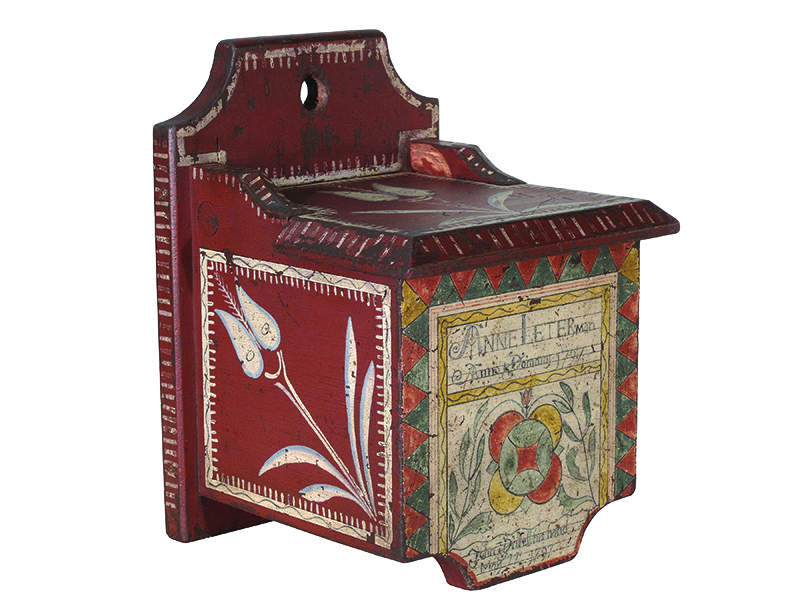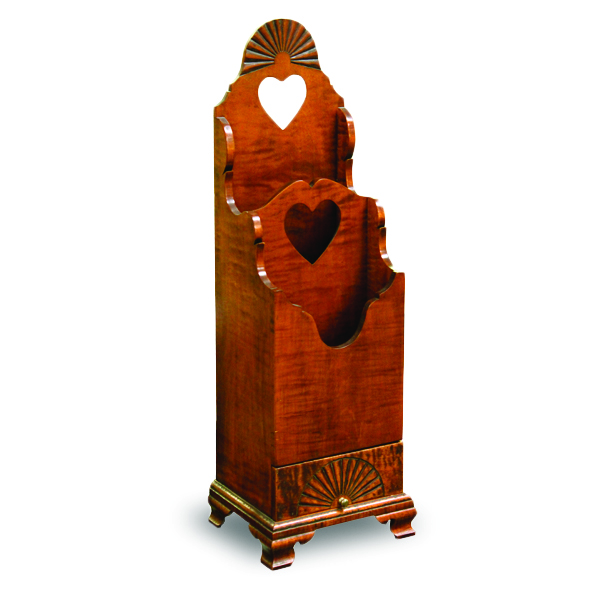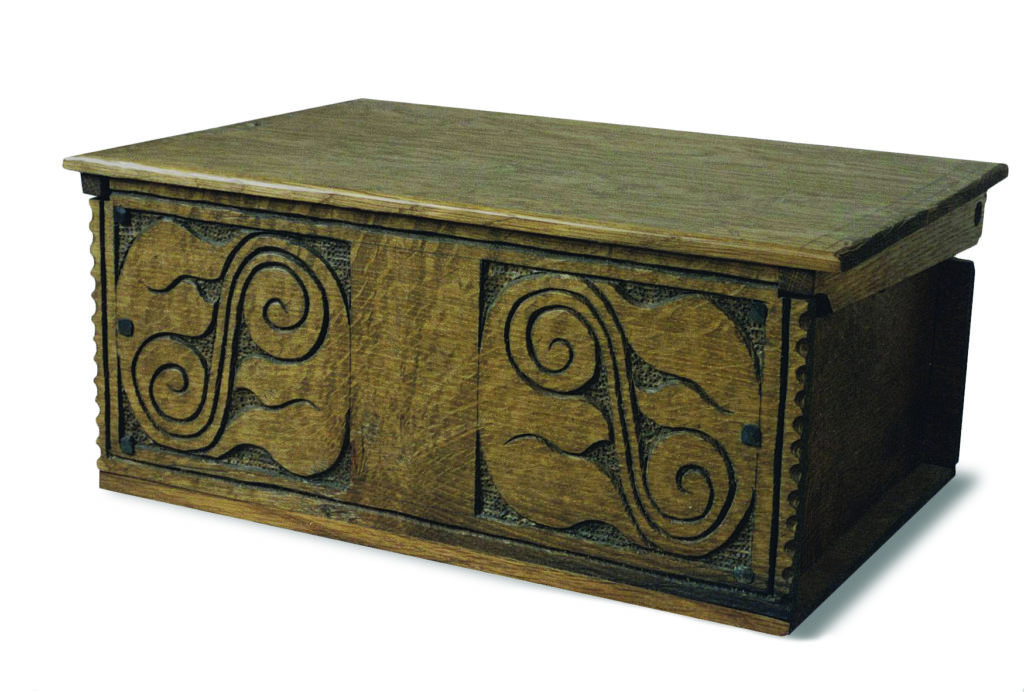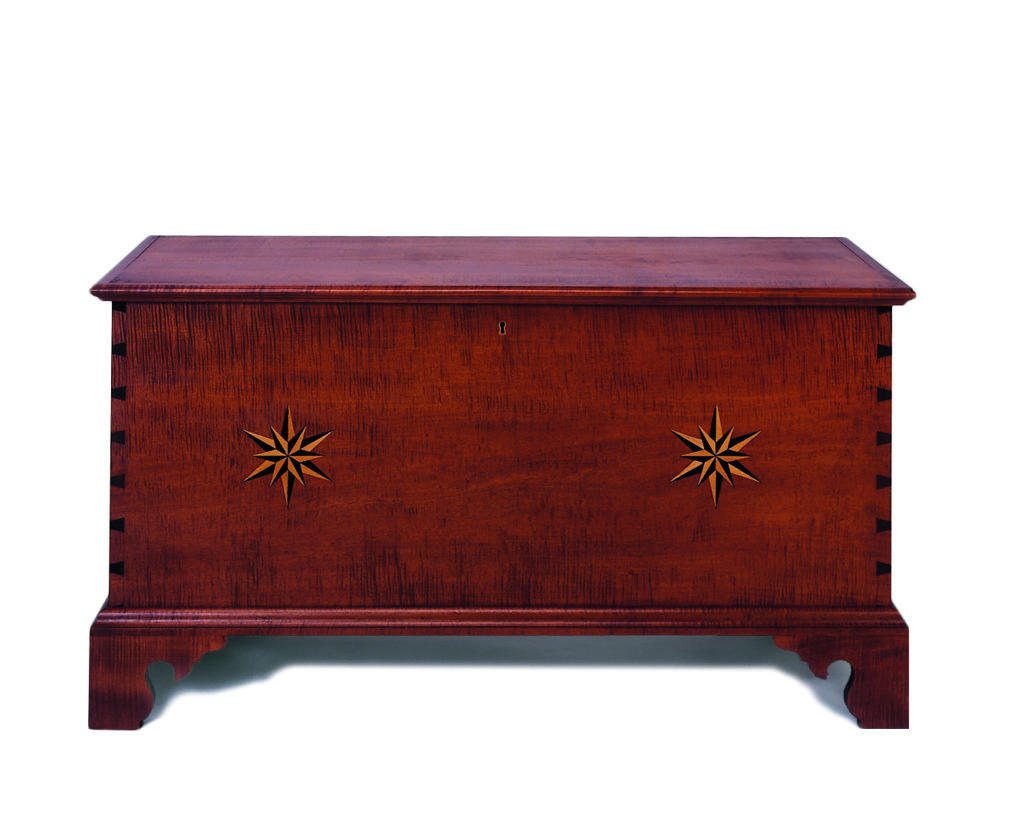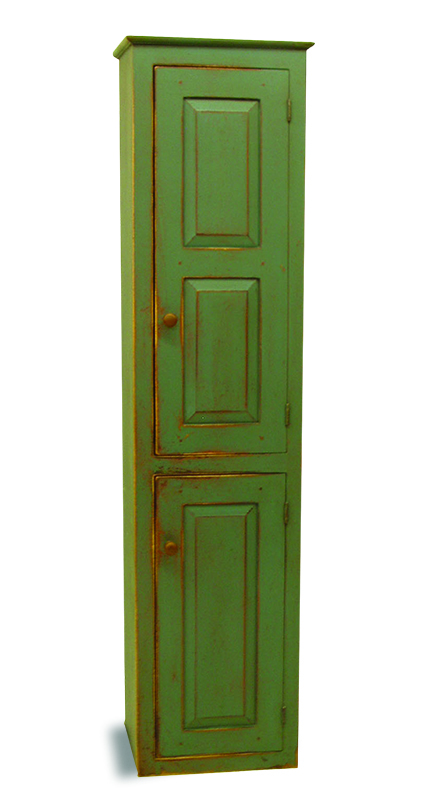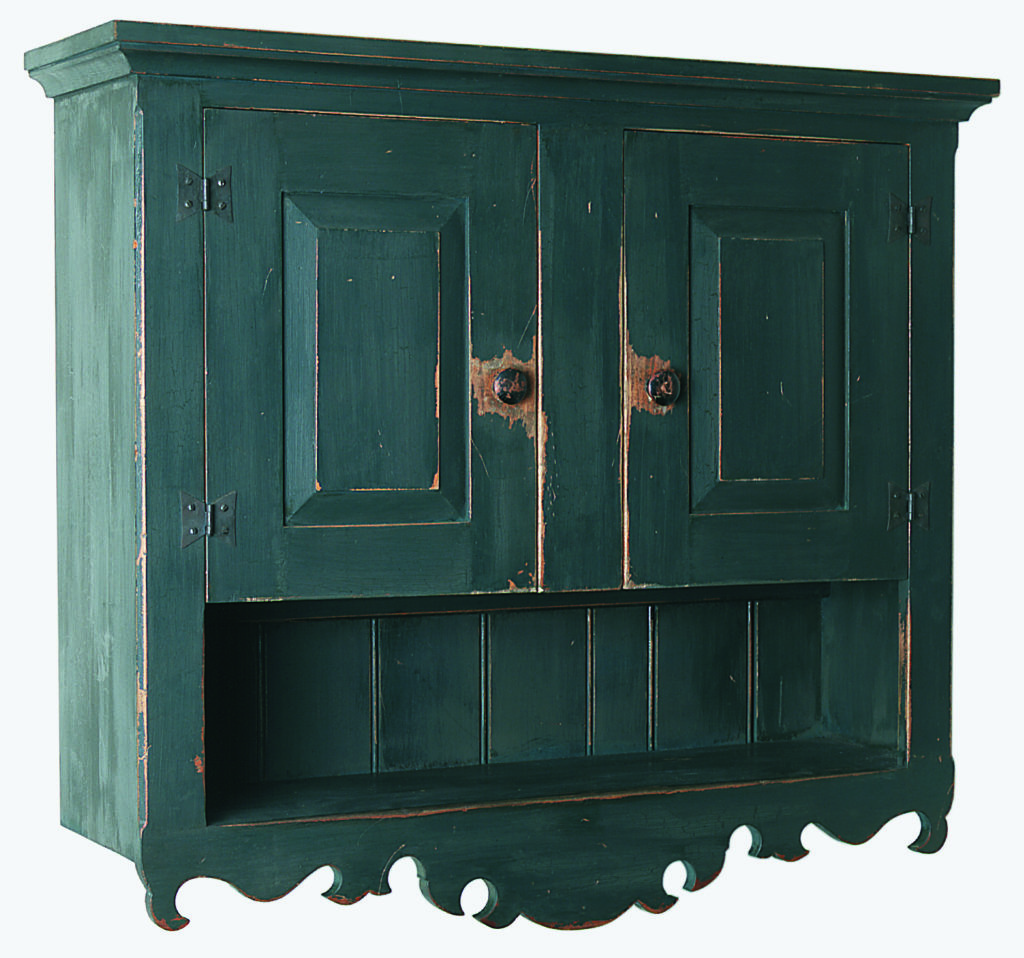In early America, spices, dishware, pewter spoons, and bed linens were treasured, hard to come by and harder to replace. Householders kept them safe by storing them in artistic and imaginative boxes, chests, and cupboards that also brightened rooms.
The most versatile type of storage was the blanket chest. Typically handmade from the abundant wood and rudimentary metals available, this deep, rectangular storage box concealed and protected bulky items like bedding and clothing from the assaults of sunlight, rising damp, and nesting vermin. When necessary, the blanket chest could also serve as a bench, table surface, or bed.
A petite 19th-century whaleback set of shelves holds a collection of tiny treasures in an owner-built replica Cape.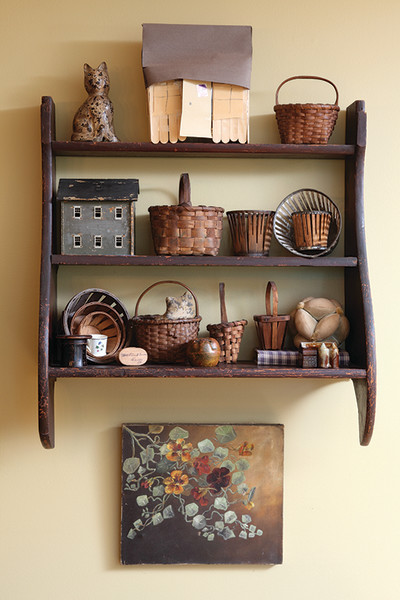
In its simplest form, the blanket chest was just a hinged lid opening onto a large wooden box. As the form grew more refined, drawers were added beneath for specialized storage, and legs raised it off those damp floors. Ultimately, the chest evolved into the standing chest of drawers common since the late 18th century.
A variety of smaller chests served specific functions. The Bible box, for example, was of a size to hold a hefty folio-sized Bible, yet it often served as a document box for valuable papers, family records, or writing materials. At an average size of 2′ wide by 16″ deep, the tops were used as writing surfaces and remained undecorated. Dedicated document boxes were usually smaller.
Wealthy families had their own specialized chests. The sugar chest was built with a locking flat-hinged top to safeguard against humidity, pests, and theft. The interior was divided into two sections, one each for light and dark sugar. Drawers beneath held tea, coffee, or spices. Since sugar was such a valuable commodity, the chest—crafted from valuable hardwood such as cherry or walnut, and often inlaid—was displayed prominently in the dining room or parlor.
The spice chest also found in the homes of the well-to-do. A luxury item, it too was made of fine wood with costly inlay, and its complicated interior design required a skilled craftsman. An arrangement of small drawers held spices, but many examples had false bottoms or backs that hid secret compartments, or cornice mouldings with a secret drawer to conceal small valuables. Perhaps most delightful are the various small, utilitarian storage items that brightened austere early interiors. These rustic pieces were often built by a country carpenter, joiner, or homeowner, and each was as individual as its maker. Spoon racks, wall boxes, saltboxes, shelves, racks, and sconces often had whimsical design elements, from lollipop- or tombstone-shaped backboards to chip carving or paint decoration.
Salt was vital to colonial food production, used to preserve fish, meat, vegetables, cheese, and butter. The saltbox always hung by the hearth, its hinged lid easy to open during cooking. Salt came in lump form and the heat of the fire helped keep it dry so that it could be pounded into free-flowing grains. Occasionally a brick was removed from the hearth to create a “salt niche” to boost drying.
The hanging spoon rack was the ancestor of those collector racks that feature shelves with slots from which spoons are suspended. While some were crafted solely to hold spoons, others included a dowel for a dish towel or sometimes a drawer for a pipe and tobacco.
Pipes frequently had a dedicated box, especially in taverns. The hanging pipe box stored communal, long-stemmed clay pipes on tiered racks or in an open box, with a tobacco drawer. Pub patrons would break off the tip used by the previous smoker until eventually the pipe was used up and discarded.
A cabinet at the 18th-century Hollister House in Litchfield County, Connecticut, appears to have been built literally into the corner of the room.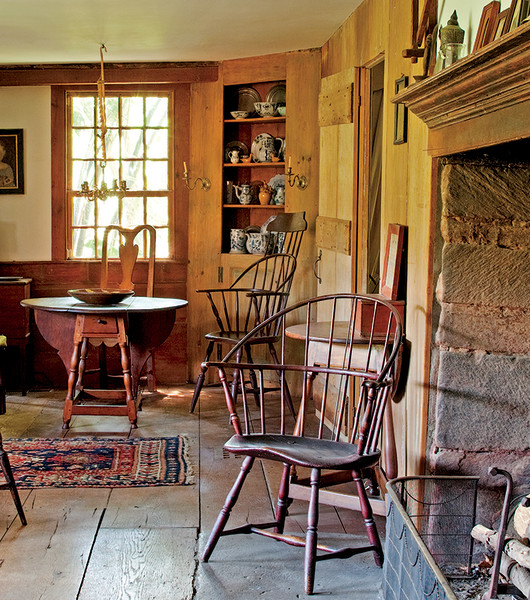
Inevitably, there was an equivalent of today’s junk drawer: the hanging kitchen box. Candles, knives, spoons, string, the rusty nail that Johnny picked up: all went into the catchall bin.
Hanging wall racks and shelves abounded. “Sets of shelves,” as they were originally called, were made of soft pine, birch, or maple. Cherry and walnut were not unknown, but soft woods were easier to manage with rudimentary tools.
Closely related to “sets of shelves” was the built-in side cupboard, an early and often rough piece. Tall and shallow in relation to height and width, side cupboards were regularly built without a back or feet. Its name may derive from its placement to one side of the room. The cupboard might have two doors, an upper and lower, or four doors, two each top and bottom, which open in the center. The most finished examples had a plain cornice, with shelves grooved to hold plates.
The freestanding cupboard, with feet and cornice, required carpentry skill. Skirt and stiles often featured carving, a popular design being the scalloped edge. This was a folk interpretation of the high-design carved shell motif introduced to American furniture with the William and Mary style (circa 1690–1730).
The fireplace cupboard was a clever use of space. It might flank the fireplace left and right, be slotted in above the mantel, or built into the sides.
Andersen & Stauffer’s painted corner cupboard is based on an 1817 original from Berks County, Pennsylvania.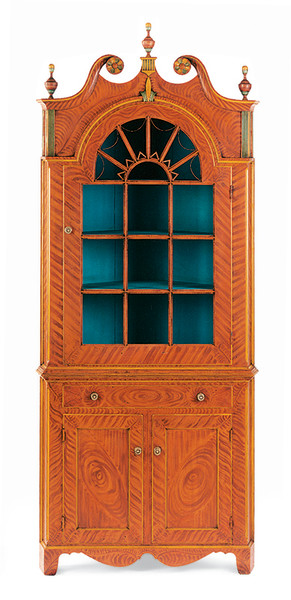
Corner Cupboards
With increasing prosperity in the 18th century, the cupboard migrated from keeping room to parlor, evolving into that great showpiece of American interior design: the built-in corner cupboard. Running from floor to ceiling, it was divided into an upper open display case and a lower, smaller, concealed storage space. Plain, oil-varnished wood gave way to a finish painted the same color as a room’s woodwork, or grain-painted to look like mahogany, rosewood, or tiger maple.
In the early 1700s, the upper cabinet took on a dome or shell shape framed by fluted pilasters and dentil moulding. Between roughly 1750 and 1790, Chippendale influence introduced the broken pediment scroll. Decorative carving in the popular patterns of shells, rosettes, bellflowers, and the like appeared and, with the emergence of Federal design (ca. 1780–1820), so did pineapples and stars.
Glass became affordable in the first years of the 19th century, and cupboards had glazed, rectangular upper doors with muntins. High-style, Adamesque cupboards in the Federal period bore increasingly ornate, semi-circular fanlight designs. Often elliptical in shape, their wood muntins were replaced by leaded glass in fanciful patterns from sunbursts to delicate spider-webs.
Period Reproductions
- Adam Mathews Furniture Maker (610) 286-9787, adammathewsfurniture.com Paint-decorated chests & cupboards of both Pennsylvania and New England traditions.
- Andersen & Stauffer Furniture Makers (717) 626- 6776, andersenandstauffer.com High-style cupboards & valuables/spice chests.
- Benner’s Woodworking, (800) 800-0611, bennerswoodworking.com Handmade 18th- and 19th-century furniture.
- Circa Home Living (888) 887-1820, circahomeliving.com Blanket chests & smaller storage.
- Colonial American Furnishings (614) 893-2336, cafurnishings.com Large collection of rustic milk-painted smalls.
- D.R. Coble & Co. (260) 665-2362, drcobleandcompany.com – Grained & fancy-painted furniture & smalls.
- D.R. Dimes (603) 942-8050, drdimes.com – Chests, cupboards, wall & corner cupboards, pipe boxes.
- Heart of the Wood (802) 879-5379, heartofthewood.com Joined, turned & boarded pieces in 17th century tradition.
- Martin’s Chair (717) 355-2177, martinschair.com Cupboards & hanging cupboards.
- Lefort fine furniture (888) 524-4907, lefortfurnituremakers.com Standard and entertainment cupboards.
- Oley Valley Reproductions (610) 689-5885, oleyvalleyreproductions.com Pennsylvania painted cupboards & chests.
- Pennsylvania Traditions (610) 584-8218, pennsylvaniatraditions.com Painted cupboards, hutches, wall boxes.
- Post and Beam Period Home Furnishings (309) 726-2662, postandbeamperiod.com Wall boxes & freestanding cupboards.
- Primitives In Pine (207) 929-4321 Wall & hanging cupboards.



